
Is a stun gun a gun? Any reasonable person’s first reaction might be, “Um, doesn’t its name say it’s a gun?” Yes, but this isn’t necessarily a reasonable discussion about what constitutes a weapon. Right now we’re talking about gun politics, which means we’re confronting an ideological and opportunistic belief system that’s capable of holding two opposites simultaneously while not seeing a contradiction. In this case, some anti-gun advocates say they don’t believe the Second Amendment should be defined as it was originally intended, but—and at the same time—they argue that an original interpretation enables them to ban every firearm technology that wasn’t available when the U.S. Bill of Rights was ratified in 1791.
In this case, a year ago, the Massachusetts Supreme Judicial Court held in Caetano v. Massachusetts that stun guns, including Tasers and contact stun guns, can be banned according to a “dangerous and unusual weapons” exception to the Second Amendment.
This all started when Jaime Caetano, a resident of Massachusetts, was convicted of possessing a stun gun in violation of Massachusetts’ ban. She’d carried the stun gun in her purse to protect herself from an ex-boyfriend.
Caetano appealed. The U.S. Supreme Court took the case. Caetano argued that the state’s ban on allowing individuals to possess stun guns violated her Second Amendment right to carry a weapon for self-defense.
The Supreme Court agreed with her. It smacked down the Massachusetts decision. Specifically, the Supreme Court set aside the state court ruling and sent the case back to the Massachusetts court “for further proceedings not inconsistent with [its] opinion.”
Now, if you’re wondering how the eight justices currently on the Supreme Court voted, we’ll never know. It was an unsigned opinion without full written or oral arguments. The Court did, however, refer to its landmark 2008 decision, District of Columbia v. Heller, as it ruled that the Second Amendment applies “to all instruments that constitute bearable arms,” even those not in existence at the time of the founding. The Supreme Court found that both of these rationales are “inconsistent with Heller’s clear statement that the Second Amendment ‘extends ... to ... arms ... that were not in existence at the time of the founding.’”
Justices Samuel Alito and Clarence Thomas also filed a separate opinion to note a few of their disagreements with the narrow scope of the decision. In it they wrote: “If the fundamental right of self-defense does not protect Caetano, then the safety of all Americans is left to the mercy of state authorities who may be more concerned about disarming the people than about keeping them safe.”
Justices Alito and Thomas also said that the Court’s opinion was “grudging” in its limited scope and that it left open the possibility that Caetano’s conviction might stand, as the state might now come up with other reasons to support its ban and thereby not overturn Caetano’s felony conviction—this could forever make it illegal for her to have “arms for self-defense.”
Whatever Caetano’s fate might be, let’s look at the bigger constitutional questions. The Massachusetts Supreme Judicial Court had ruled that stun guns aren’t protected by the Second Amendment because stun guns were not in common use at the time the Second Amendment was written and ratified. It also ruled that these nonlethal weapons fit within the “dangerous and unusual weapons” exclusion to the Second Amendment. The Supreme Court found that both of these rationales are “inconsistent with Heller’s clear statement that the Second Amendment ‘extends ... to ... arms ... that were not in existence at the time of the founding.’”
The Supreme Court is clearly right, as these nonlethal weapons—stun guns are, of course, potentially lethal if used on someone with a heart condition—are less dangerous than a flintlock pistol George Washington might have carried.
Nor are stun guns unusual. There is a robust marketplace at Amazon.com and many other retailers for stun guns in all shapes and sizes. It is unclear just how many people currently carry them, but they are hardly uncommon. In a Michigan case in 2012 (People v. Yanna) the court found that “[h]undreds of thousands of Tasers and stun guns have been sold to private citizens, with many more in use by law enforcement officers.” They certainly aren’t “unusual.”
Finally, the Massachusetts court said there is “nothing in the record to suggest that [stun guns] are readily adaptable to use in the military,” as if citizens can only own and carry guns used by the U.S. military. The Supreme Court also overruled this rationale by noting, “Heller rejected the proposition ‘that only those weapons useful in warfare are protected.’”
This is an important ruling, as it notes that the right to bear arms is modern and broad in its scope. This is consistent with how other rights protected by the U.S. Bill of Rights are viewed legally. No one argues today, for example, that First Amendment free speech protections don’t extend to new technologies like the Internet, radio or TV, so how can anyone say new gun technologies aren’t covered?
Still, as Justices Alito and Thomas pointed out, this is a very limited ruling. As it is unsigned, it also tells us little about the current balance of the court with regards to the Second Amendment. There is no doubt that the next president of the United States will be able to point this Court toward or away from freedom—all of this rides on what the voters decide this November.


































